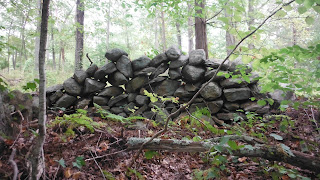Another one of those persistent Yankee Stone
Wall Myths that just won’t go away is the Tree Fall Damage scenario, used to
explain away why a “stone wall” can’t be an Indigenous or Native American
created Snake row of stones or Qusukqaniyutôk
that intentionally undulates vertically, like a snake moving across the
landscape.
Mr. Oxford Dictionary defines undulation as “a smoothly rising and falling form, outline, or movement.” My old friend Ox uses this example in a sentence, as many other members of the Dictionary Family do in their writings: "The road follows the undulations of the countryside," and one could stick a couple other words in there and say “The Yankee Stone Wall follows the undulations of the countryside.” But that may also be true of a row of stones artistically stacked or laid using elements of Indigenous Iconography, sometimes resembling a Great Snake, often composed of smaller snake effigies as well as other effigies both zoomorphic and anthropomorphic, sometimes appearing to shapeshift into another effigy, possibly related to control of water or fire (sometimes both) on Sacred Cultural Landscapes that are beginning to be recognized as Indigenous Ceremonial Stone Landscapes.”
From a perspective of distance, the largest of the Stone Snake
Qusukqaniyutôk snake across the
landscape, crossing over others, sometimes connecting great boulders or bedrock
outcrops, sometimes along streams – and sometimes stacked over and hiding a
stream, a Musical Row of Stones - the sound of water is the Great Snake
contentedly “purring.”
Inside some enclosures, there were “gardens,” plant
resources perhaps tended by fire, perhaps protected from fire, something living
kept in balance, kept in production by someone offering tobacco to a serpent
guardian before entering, someone singing while stacking stones, picking up and
replacing her grandmothers’ and grandfathers’ stones that have fallen.
Zigzag and linear rows of stones, snaking across the landscape, sometimes can be found still on both sides of a modern road whose origin was an Indian Path or Native American Trail or an Indigenous Road that’s
possibly two or ten or twelve thousand years old, and may well be Indigenous made Snake Effigies, connecting those "gardens" and linking Indian Villages…
While it may be true that trees damage those constructions we insist on calling stone walls even though these alleged fences are not the spaces between floors and ceilings, I’m personally inclined to believe that many of these undulations are intentional and are a distinguishing characteristic of Indigenous Stonework, with many artistic variations, ranging from “slight and gentle” to some that are very “tall and strikingly sharp.”
An especially good example, on a property that’s
been a nature preserve since 1913, begins with a variation of a snakehead on a
bedrock “bald” or outcrop connected to a row of stones that smoothly rises and
falls, suggesting to the poetic a snake basking in the sunlight when it’s sunny
(or something else, depending on local conditions - such as sleeping under a blanket of snow):

There’s many more Vertically
Undulating Stones of Intention at this place and in others – places where
Guardian Great Snakes help humans keep the world in balance, controlling
weather, controlling wildfires and ceremonial fires of World Renewal, snake
bodies surrounding “gardens” of many types, of many variations.
















No comments:
Post a Comment